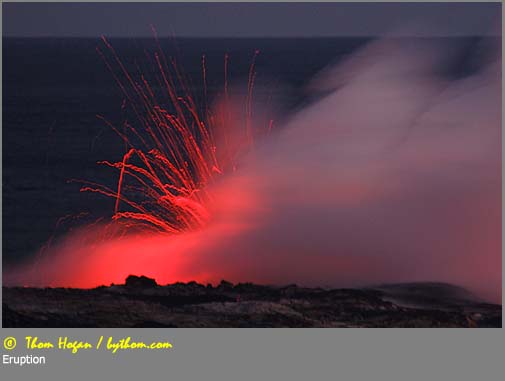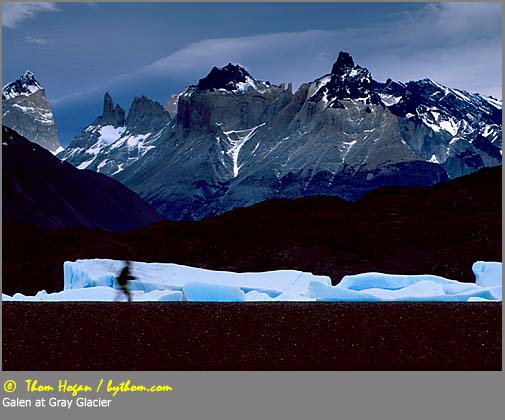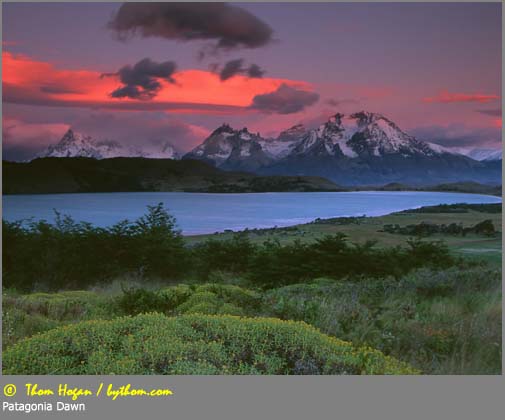



 |
 |
 |
 |
We are trying to develop a fun community where photographers can come and discuss nature, wildlife and pet photography related matters. We encourage you to enter the forums to share, make comments or ask questions about this interview or any other content of NWP.
This article is Copyright 2005, James Morrissey, and may not, in part or in whole, be reproduced in any electronic or printed medium without prior permission from the author. The images in this article are the property of Thom Hogan and have been licensed to James Morrissey and the NWP Photo Forum for the purpose of this interview.
Part I: About Thom

JM: Would you give us a short social history about yourself?
TH: Unfortunately, I like to talk and my history is filled with things to talk about, so I'm not sure I can honor the "short" part of the question. (Smiles) I'm an only child whose parents taught him to be independent, curious, and hard working. That was a recipe for an amazing number of twists and turns along the way. The short answer, I guess, is that I've always followed my curiosity, and I'm an incredibly curious individual. Thus, my track record runs across so many disciplines and trails I sometimes forget them all. I like to say my life has been a remarkable random walk.
JM: When and how did you begin with photography?
TH: I have my mom to thank there. She's always had an artist side to her (these days she paints), and when she started exploring photography as I was growing up I got curious and did, too. So much so that when my dad and I built a house for us while I was in high school, I designed a dark-room into it. And borrowed my mom's Nikkomat FTN when she wasn't looking. I shot for the school and local newspapers, and then did some photography on the side when I went to college and majored in film making. Some of the promotional stills we used at the television station were my photos, though at the time I wasn't thinking of them as "mine."
JM: At what point did you decide that you wanted to be a professional photographer?
TH: I'm not sure I have! Being a full-time professional photographer is more work than most people think it is. I'd have to consider myself a part-time photographer and full-time writer right now. But the answer to your question is a story I often tell at workshops: I was in Seattle interviewing for a position running development at Real Networks when I noticed an employee ad in the Sunday Seattle Times-Intelligencer: "Backpacker seeks executive editor. Call John Viehman at XXX-XXX-XXXX." That was pretty much the whole ad. I have no idea how it caught my attention, but it did, and it got me started thinking about switching my vocation (running product development in high tech) with my avocation (enjoying the outdoors and recording my experiences there). I clipped the ad and brought it home with me. I didn't call the number immediately; I remember it being well more than a month before I did, and it was more than six months before I actually joined Backpacker magazine, so finding that ad was just the start of a slow dance. Interestingly, the thing that kicked it over the edge was Galen Rowell. John knew Galen and knew that Galen knew me. Unbeknownst to me John called Galen and asked for a recommendation, which Galen gave freely even though I had never even told him I was applying for the job. That's just one of the many reasons why I continue to try to tell Galen's story these days, by the way--he was a great man, photographer, and writer who influenced many people's lives, sometimes without them even knowing.
JM: What types of professional photography have you worked in (i.e. stock, publishing, portraiture, weddings, etc) prior to having developed the camera Field Guides?
TH: Most of my professional work prior to the first Nikon Field Guide was actually in film and video. I used to carry a still camera with me, too, and sometimes I'd come away with some good photos. But my first goal was always motion images. I sold a few photos along the way when people would see them and had a need for them, I used a few in publications I put out (I edited a number of magazines and wrote quite a few articles and books along the way), but for the most part my still images sat in my files. When I started taking three-week trips into the wilderness once a year to get away from the pressures of high tech, I started simplifying and just took a still camera. That's when my current interest in nature photography really got started. As for weddings, I run from them, though given my portraiture and lighting skills I'd probably do okay. With wedding photography one mistake and you could be done for forever. With nature photography, you do what you want at a leisurely pace and no one has to see your mistakes (and there will be mistakes).

JM: Who are your biggest photographic influences?
TH: I've already mentioned Galen. Over the course of a little more than a decade I probably spent as much as five or six months with him photographing in great natural settings. It would be difficult to spend that much time with any photographer and not have something rub off on you, but as I've said, Galen was a great man, and things came out of his mouth that just washed over you and overwhelmed you if you weren't careful. He taught me so many things that I just can't begin to mention them all. But the biggest influence he had was in something he didn't teach me, but forced me to learn on my own. There's a tendency when you're at the coat tails of a great master to imitate the master. Galen's most important words to me were that I needed to find the place from which MY pictures came, not his. He had no idea what that might be, but he knew the point when I had the skill set necessary to start figuring it out, and he just started pushing me on figuring that out. Sadly, I now have a pretty good idea what motivates my photos, but I'll never have a chance to have a discussion with Galen about that. I think it would be quite an interesting discussion, actually.
JM: Where does your photographic education come from?
TH: Galen wasn't the only influence. As I said, I have an undergraduate degree in film making (and a masters in television production), so I've had formal training in imaging and lighting along the way. When I started getting back into photography in the late 1980's after a long period of not having a camera, I also began the practice of taking a University of California extension class once a year. Some were just weekends, some a few weeks, but all were with some extraordinary teachers. For example, James Katz runs a rafting company called James Henry River Journeys, but used to teach weekend classes in Pt. Reyes once or twice a year. Not only is he a good photographer, but he's a good teacher, and I picked up a few things from him I wouldn't have encountered elsewhere. John Senser is a naturalist turned photographer who taught for UC, as well. Some of my favorite Yosemite shots I've taken came while under his tutelage. Unlike Galen, those names may not ring bells, but both actively teach workshops and sell images. And that's one of the interesting things about this business: there really are a lot of good teachers and resources for someone who's really interested in pursuing nature or wildlife photography. Lots. If you don't believe me, check out the Shaw Guides site and be prepared to be overwhelmed with the number of workshop choices you have.
JM: Do you have a business education?
TH: Funny you should ask that. As part of my Ph D program at Indiana University (in New Technology Economics and Management) I took the MBA course-work. My mentor at the time was trying to get me the training and knowledge that would let me become an executive at NBC, where he consulted. Since you can't get two degrees for the same course-work, given the timing I probably made a big financial mistake by not getting the MBA. (Smiles again) Now, all that seems irrelevant, right? Not really. Sometimes I think you almost need an MBA to make it professionally in photography. Most people really only see the photographs (and occasionally meet the photographer). It looks easy. Heck, it used to only take a $500 camera and a $3 roll of film, so it probably was inexpensive to get into, too. Wrong! If you look behind every successful nature and landscape photographer you'll see a very hard working businessman or woman. The one thing I always envied about Galen wasn't his climbing or photography or running or writing skills; it was the fact that Barbara ran his business and freed him to only deal with his creative side. Me, I'm not only single but don't even have a girlfriend, so I have to run the business as well as do the creative. You see one or the other over and over: either the photographer is paired up with someone who does most of the work in keeping the business side going, or the photographer themself has a very strong business background and work ethic. The alternative is to be a starving artist who's work, if ever, is discovered long after you've passed. Not that there's anything wrong with that if that's what you want. Nature photography can be a soul soothing endeavor. But if you want to do it for money, get ready to work harder than you've ever worked, and most of that work won't be taking pictures.
JM: When we were discussing your photographic influences, you commented that when you were working under Galen Rowell's tutelage, he was constantly pushing you to find the place from which your pictures came from. What is it that motivates you?
TH: Well, in the main, it's the same thing that motivates every nature photographer: we want you to see what we saw or more importantly, felt. How the place affected us. I suppose my wording before wasn't quite right--when I talked about where the pictures come from, I was talking more about a personal sense of photographic style. Those that have seen some of my more recent work know that I've lately tended towards what I guess I'd call a "we're all small things in a big place" kind of style. I've got a series of photos I've taken I call my Big Sky series, where I take pictures of very recognizable natural icons, but they form a miniscule part of the image. Styles evolve over time, and you respond to different things. I guess to put it properly, Galen was pushing me to make sure my photos were my response to what I was confronted with, not something that mimicked his or other photographers'.

Patagonia Dawn (c) Thom Hogan
JM: Does this also motivate your personal life?
TH: Funny you should ask that. I've been teaching a variant of what I've figured out at my workshops, something very different than what I've seen others teach, actually. It's sort of a mantra short cut to get to your own style and evocation. It only took me 10 years to figure it out, but I can teach it in 10 minutes--go figure. But one thing I realized is that, yes, it carries over into other things. I think that as we mature, we're always looking for ways to explain why we're here, what our role is in the world, and what we'll leave behind. So, yes, I started looking at life just as intensely as I look at nature.
And you can see some of the carry over in my dedication to preserving the natural world. I take photos of nature because I want to show the wonders of the world to others who might not have been lucky enough to go there and see them. But my charity work is mostly about making sure that future generations will also be able to go there and see them. I'd be chagrined if some day the only thing left of the view at Admiralty Lake is one of my photographs, not the place itself. Yes, I know places evolve and it'll never quite be the same as the moment I was there, which is one of the reasons why we photograph, but we ought to at least try to have places that evolve naturally, not get paved over for parking lots and condos.
JM: Can you share more of how you first met Galen Rowell? You mentioned earlier in the interview that he was called by the editor of Backpacker for a reference on you. Under what circumstances did you know him prior to your beginning to work in the professional community?
TH: Well, I have a whole article on that on my site (see http://www.bythom.com/chasing.htm). It really was one of the random events that change your life in ways you can't foresee. Essentially, I got sucked into one of his workshops by accident, and not just any workshop, but a three week tour of Botswana. Thus, right off the bat I spent a lot of time with him, and we hit it off. By the time the Backpacker job came along, I had trekked with Galen in the Andes and met up with him many times on the trail as well as his local gallery and offices. And, of course, I sucked up everything he had written and managed to ask intelligent questions about most of that, which I think impressed him enough to tolerate my hanging around.
JM: We were discussing families earlier...at one point, you mentioned that you envied Galen because of his strong symbiotic relationship with his partner, Barbara. You also said that many couples in the photography business are like this. Do you feel that your busy lifestyle has paradoxically prevented you from being able to have this sort of relationship?
TH: You bet. I'm either stuck in the office trying to catch up, or I'm out in the middle of nowhere taking photos. I'm also at an age where I'm focused on trying to get things done while I've got the energy and stamina to do so. In Galen's case, he met Barbara when she worked for North Face. She decided the North Face catalog needed shots of people actually using their products, and hired Galen to do that. And they clicked. So I guess there's hope for me yet.
JM: More importantly, is it something that you want for yourself?
TH: Yes, and I think that every successful nature photographer really has to have some close relationships that work for them, whether they be familial or just friendly. I mean, if you sit in bird blinds for 16 hours a day for a week and that's all you do, you're headed towards that starving artist who's remembered only after death kind of existence, which seems just a bit too unconnected for me. Observing and photographing nature seems to me to be about our connection to it, so if you're disconnected, you'll have a hard time making interesting photos. But you've probably also noticed that I've mentioned more than once in this interview things that speak to my purpose in life. If my purpose in life is just to exist and do what I want to and nothing else, then that's a pretty shallow purpose, isn't it? I'd like to think that I had a positive impact on others, that I shared what I saw and did with others in some meaningful way, and that they had the same affect on me.
On Wednesday night, we are going to put up Section II of this three part interview. Section II will encompass the aspects of Thom's business. Section III, which will be published on Sunday night, will talk about Thom's feelings on varoius environmental issues.
Come join us in the NWP Business forum to discuss this interview. You can also click the 'Home' link to go back to the front page and read other interviews and articles.
 |
 |
 |